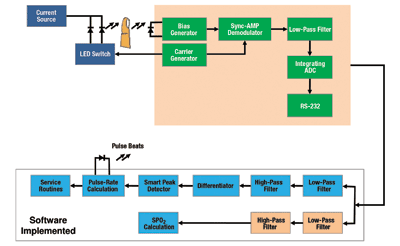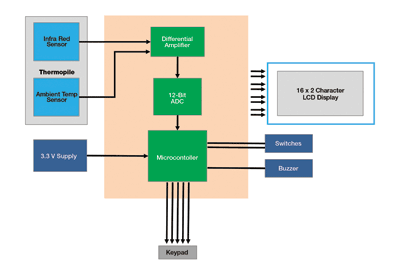Implementing PSoC into portable devices offers advantages to system design
BY PAVITRA RAMANUJAM and SHAMIK MEHTA
Cypress Semiconductor, San Jose, CA
http://www.cypress.com
The movement of patient care away from hospitals and clinics and into homes is a growing trend. Portable medical electronics technology can expedite this process. In their most basic form, portable medical devices are all battery-operated microcontrolled handheld devices that take and analyze measurements using various bio-sensors on a patient.
Several functional blocks are common to most portable home-based and consumer medical devices:
* Bio-sensors or bio-transducers.
* Amplification and analog-to-digital conversion of the sensor input.
* Power management: system power control and power sequencing.
* Microcontroller: low-power operation and control.
* User interface: display and human machine interface, such as keypads, scrollwheels, buttons and switches.
Additional requirements may drive the need for storage, both interface to multiple standards, wireless and wired interfaces, and audio feedback or notification.
Portable medical devices must offer low-power consumption to extend battery life. Making the device robust and adhering to health governance rules are additional requirements. And like all designs, faster time-to-market, low cost, reliability and small form factors are important.
In the arena of portable medical electronics, it is generally difficult for designers to make tradeoffs between opposing features, specifications, and space constraints. The requirements in this market include the need for a small form factor, high functionality, low power consumption, high-performance analog, long battery life, and high processing capability.
An example system is a portable patient-vital-signs monitor that measures blood pressure, heart rate, pulse oxygen, and temperature using IR thermometry. Using a programmable system-on-chip (PSoC) in this design reduces design complexity by offering configurable integration of the complete signal chain for analog signal processing, resulting in significant space and cost savings. A single PSoC can accomplish all the control functions needed in this design, performing different tasks at different times depending on the operation taking place.
A patient-vital-signs monitor using PSoC has the advantage of emulating most of the required peripherals inside one chip. A single PSoC includes flash and SRAM memory, an MCU, ADCs, PWM, filters, USB control, and capacitive sensing. An LCD drive is integrated into the PSoC. Only the pressure transducer and the LCD display are external.

Fig. 1. Blood -pressure monitor using PSoC.
The entire signal chain for the analog signal processing of blood pressure pulses is configured inside the PSoC. This design interfaces to an external pressure transducer, the blood pressure cuff, and the motors that drive the airflow in the air chamber with a relay valve and rolling pump. An external display interfaces to the PSoC to provide better readability of physiological data.
Blood pressure measurement
Blood pressure is measured using the oscillometric method, where intra-arterial pulsations are transmitted to the cuff via a pressure transducer. Systolic and diastolic blood pressure are measured from the amplitudes of the oscillations.
Systolic blood pressure (SBP) and diastolic blood pressure (DBP) are obtained by identifying the region where there is a rapid increase then decrease in the amplitude of the pulses. Mean arterial pressure (MAP) is located at the point of maximum oscillation.
The cuff pressure signal is measured in millivolts. Hence the raw cuff pressure signal goes through a two-stage amplification to obtain maximum gain.
A bandpass filter is necessary to filter out unnecessary pulsations produced by the artery, which is in ranges higher than the cuff pressure signal. Next, a dc level is provided as a baseline for oscillations; the ADC must read the signal with respect to this baseline reference level.
The baseline has to be maintained at the same level, or the amplitude of the oscillations may not get measured correctly. The actual calculations are done by software running in the PSoC’s microcontroller.

Fig. 2. Pulse oOximeter using PSoC.
Pulse oximetry uses oxygen saturation. Oxygen saturation, often known as SaO2 or SpO2 , is the ratio of oxyhemoglobin (HbO2 ) to the total concentration of hemoglobin present in the blood (oxyhemoglobin + reduced hemoglobin). The wavelength range in the near infra red part of the electromagnetic spectrum is the range for which there is least attenuation of light by body tissues (tissue and pigmentation absorb blue, green, and yellow light; water absorbs the longer infrared wavelength).
With pulse oximetry, only the part of the signal that is directly related to the inflow of arterial blood into the body segment is used for calculating oxygen saturation. A pulsatile signal, which varies in time with the heart beat, is superimposed on a dc level. This is a cardiac-synchronous pulsatile signal. If we assume that the increase in attenuation of light is caused only by the inflow of arterial blood into the fingertip, we can calculate the oxygen saturation of the arterial blood by subtracting the dc component of the attenuation from the total attenuation, leaving only the cardiac-synchronous pulsatile component for the dual-wavelength determination of oxygen saturation.
The only external components required are infrared and red LEDs, photo detectors capable of detecting the LED emissions and discrete components to match and tune the characteristic LEDs and detector. External LED drivers are required to produce maximum current transfer to match illumination conditions.
The calculations are again done in software run by the microcontroller inside the chip.

Fig. 3. IR tThermometer using PSoC.
This design uses an infrared sensor, which is little more than a thermopile, with a micromachined membrane embedded with thermocouple junctions to measure ambient temperature. The thermocouple provides a temperature differential between hot and cold junctions. A DC voltage corresponding to the temperature difference is generated by the thermocouple. An electric potential is created in the thermopile junction as a result of the temperature difference in the membrane. The sensor also has an integrated thermistor to compensate for ambient temperature.
Temperature is calculated in software by using a correlated double sampling algorithm; effective in analyzing slow varying analog signals in presence of large volumes of low-frequency noise and dc voltage offsets.
Software tools
PSoC Designer is an integrated design environment tool that combines the convenience of drag-and-drop with the ability to add C or Assembly language code on the fly. The software also has many pre-characterized and configured analog and digital user modules. It has an integrated JTAG programmer and debugger which allows for real-time emulation of the program plus code download to the processor’s nonvolatile memory. With this tool, a designer selects components (counters, PWM, ADC, DAC, etc.) from a catalog, and then can modify the design using an integrated C/Assembler editor, and then program and debug the design.
All three functionalities of the patient vital signs monitor use the same external peripherals like LCD, keypad, and power sources. The only variables are the transducer sections. In all three functions, the signal chain is emulated inside the chip and software calculations for signal processing runs in the PSoC’s microcontroller. This design approach reduces components, and allows for fast and easy changes, even late in the design cycle. ■
Advertisement
Learn more about Cypress Semiconductor





